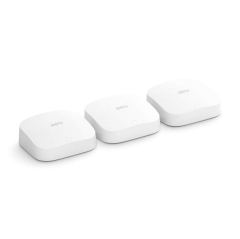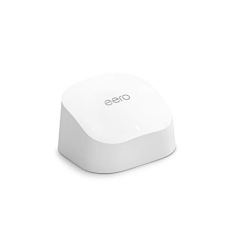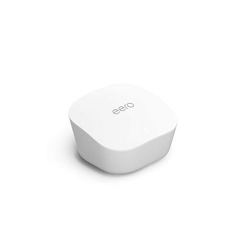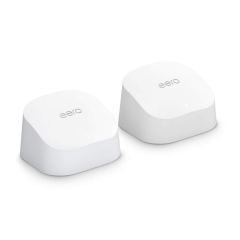BestReviews is reader-supported and may earn an affiliate commission. Details

This three-router pack creates an up-to-date WiFi 6 mesh system over a large area.
This three-router pack creates an up-to-date WiFi 6 mesh system over a large area.
Gigabit speeds. Intelligent routing. Covers 6,000 square feet. Uses tri-band WiFi 6 to support 75+ devices. Connects to Alexa. Can be a Zigbee smart home hub.
An expensive way to deploy wireless networking.

If you are already paying for especially fast internet, the eero 6 is worth the investment.
If you are already paying for especially fast internet, the eero 6 is worth the investment.
Top speeds of 500 Mbps. Covers up to 1,500 square feet. Fairly affordable. Quick setup. Utilizes fast and strong Wi-Fi 6 technology. Built-in smart home hub. Dual-band.
Expanded security features require a subscription.

The original eero is the best bet to get started with a mesh network on a budget.
The original eero is the best bet to get started with a mesh network on a budget.
Affordable. Single router covers up to 1,500 square feet. Quick setup. Optimized for Apple HomeKit. Alexa-compatible. Automatic updates. Secure system. Dual-band technology.
Least impressive 350 Mbps speeds.

A great way to reap the benefits of a basic WiFi 6 mesh system.
A great way to reap the benefits of a basic WiFi 6 mesh system.
Covers 3,000 sq. feet with extender. 500 Mbps speeds. Supports over 75 devices on a network. Dual-band and WiFi 6. Works with Alexa. Works as a Zigbee smart home hub.
Not capable of speeds over 500 Mbps.

Cover a wide area at gigabit speeds with this 3-router mesh network pack.
Cover a wide area at gigabit speeds with this 3-router mesh network pack.
Tri-band WiFi networking. Each router offers two gigabit Ethernet ports. Three-router system covers up to 6,000 square feet at gigabit speeds. Compatible with Apple HomeKit.
A little pricey. Doesn't support WiFi 6.

We recommend these products based on an intensive research process that's designed to cut through the noise and find the top products in this space. Guided by experts, we spend hours looking into the factors that matter, to bring you these selections.

Mesh WiFi systems are popular today, and for good reason. Mesh networks use upgraded technology as compared to the traditional WiFi router setup and allows for the successful connection of dozens of devices at once. What’s more, a mesh network handles these simultaneous connections far better than a traditional WiFi router.
For your home or business, a mesh network can create a stronger overall WiFi network than you might otherwise have. The mesh technology boosts signal strength among each of the pieces of hardware in the network, eliminating the dead spots that often plague WiFi networks. Mesh can reduce the problem of dropped connections, too.
One of the originators of mesh networks is eero. This company has been making mesh network hardware and software for several years, and it has multiple models available to match your WiFi needs, including hardware that uses the recently released WiFi 6 standard. In this guide, we discuss the key features you need to understand when shopping for the best eero WiFi system.

Let’s discuss how mesh networks work and how eero systems work. You then can determine whether one of these systems would suit your needs.
Before mesh networks, there were traditional routers. If you have a home where the bedrooms and media rooms are spread far apart, the signal from a traditional router may not reach every room with useful signal strength.
In this case, you could add extenders to your traditional WiFi router network. A WiFi extender captures the signal from the router and boosts it to create a greater coverage area. However, extenders can be tricky to set up and use, and they don’t carry as much power as the original router. Because an extender can be a weak link in a network, in many circumstances, mesh is preferable.
A mesh network uses more than one piece of hardware to push the wireless signal throughout the home, much like a traditional router and extender. Each piece of the mesh network has the same level of power and connectivity, which simplifies setup and guarantees a smoother signal strength everywhere.
An eero network uses patented TrueMesh technology to deliver the benefits of mesh. You place the eero devices in different locations in your home, allowing the signals from each device to overlap slightly, guaranteeing full coverage.
As part of TrueMesh, eero uses software to manage the network, meaning it happens automatically. The software measures the data usage on the network and the types of devices that make connections. It also places devices on the 2.4 GHz or 5 GHz band automatically, depending on the needs of the device.
After running the data through algorithms, TrueMesh adjusts its performance to deliver higher data speeds to the areas of the home that see the most traffic. Should TrueMesh measure a problem in a certain portion of the network, it adjusts the performance of the hardware devices to ensure an uninterrupted signal.




















Let’s take a look at the eero kits available and some of the features they offer.
eero Pro 6: With three devices in this product, the Pro 6 provides up to 6,000 square feet of coverage. It supports the WiFi 6 standard, delivering performance to match ISPs that offer speeds up to 1 Gbps (or 1,000 Mbps). It has tri-band technology, meaning it carries one antenna for the 2.4 GHz band and two antennas for the 5 GHz band.
eero 6: The eero 6 with three devices is able to cover up to 5,000 square feet. It supports WiFi 6 standards using dual-band technology (one 2.4 GHz and one 5 GHz band). It works well with ISP speeds of up to 500 Mbps.
eero: With the eero, you receive dual-band technology. This three-pack of devices supports WiFi 5 standards and covers up to 5,000 square feet. It works best with ISPs that support up to 350 Mbps of data transmission speeds.
You may find some older eero products for sale, but these will have significantly slower performance than its current models.
If you were to purchase one of the three eero systems we’ve discussed with one device instead of three in a kit, note that you’d receive about 1,500 square feet of coverage with the eero 6 and the eero and about 2,000 square feet of coverage with the eero Pro 6.

You have the option of adding single devices to your existing eero network to provide a bit more coverage. These extender single devices have the same features as the original eero devices in the kits.
eero 6 Extender: With the eero 6 Extender, you can add about 1,500 square feet of coverage to an existing WiFi 6 mesh network.
eero Beacon: The Beacon works with WiFi 5 networks, adding about 1,500 square feet of coverage.
One alluring benefit of a mesh WiFi system is ease of setup.
When purchasing eero gear, you can expect to pay $75 to $125 for a single piece of hardware for older technologies (WiFi 5 and older) and $100 to $225 for newer technologies (WiFi 6).
Many times, eero mesh systems appear in kits with two or three pieces of hardware. You may pay $125 to $350 for a kit with older technology and $200 to $600 for a kit with newer technology.

Here are some troubleshooting techniques to help you set up and run your eero network.

A. A WiFi router often has large antennas that extend away from the hardware; these antennas are used to create a directional signal. However, eero hardware doesn’t need antennas because mesh networks have the signal strength and quality to negate the need for directional signals. The eero hardware resembles a simple box, roughly the size of a deck of playing cards, which is a bit smaller than a traditional router.
A. The benefits of WiFi 6 technology include significantly faster transmission speeds as compared to older versions of WiFi. Further, it gives you the ability to support dozens of simultaneous device connections without a drop-off in performance. Mobile devices also require less battery power to use the WiFi 6 network than they do older WiFi technologies.
A. Yes. The hardware automatically receives regular upgrades and security patches. You don’t have to install the patches yourself. Additionally, the eero app provides statistics and warnings about threats to the network.
Get emails you’ll love.
Learn about the products you’re wondering if you should buy and get advice on using your latest purchases.
